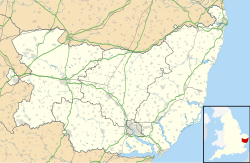| Fornham St Martin | |
|---|---|
 Village sign Fornham St Martin | |
Location within Suffolk | |
| Population | 1,300 (2005) [1] 1,319 (2011) [2] |
| District | |
| Shire county | |
| Region | |
| Country | England |
| Sovereign state | United Kingdom |
| Post town | Bury St Edmunds |
| Postcode district | IP28, IP31 |
| Police | Suffolk |
| Fire | Suffolk |
| Ambulance | East of England |
Fornham St Martin is a village and civil parish in the West Suffolk district of Suffolk in eastern England. Located on the northern outskirts of Bury St Edmunds off east and west from the A134, in 2005 its population was 1300. [1] Its parish council is shared with neighbouring Fornham St Genevieve, and is known as Fornham St Martin cum St Genevieve Parish Council. Fornham St Martin is one of a trio of contiguous villages by the River Lark. The other villages are Fornham St Genevieve and Fornham All Saints.











